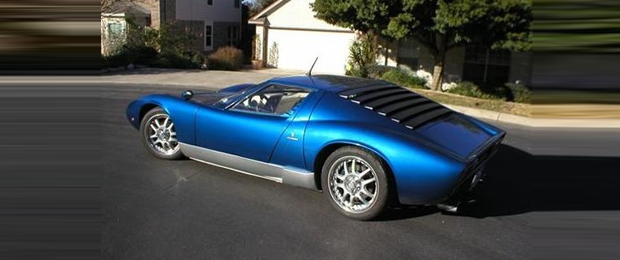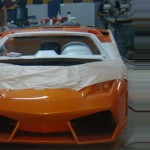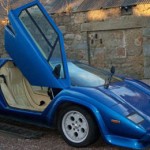Some have called the Lamborghini Miura one of the most beautiful cars on the road and if you look at the lines of the Miura, you can certainly see why. It does not have the distinctive wedge-shape of the Countach – indeed; you can certainly distinguish a Countach when you see one. Instead, the Miura’s voluptuous lines are, like the lines of the E-Type Jaguar, distinctive and, in their way, quite beautiful.
This is another of the cars designed by Lamborghini’s own Marcello Gandini. Indeed, since it was released before the Countach made its appearance, one can speculate that the Miura was probably one of Gandini’s very first design tests for the famed Italian automaker.
Interestingly, the owner of the company, Ferruccio Lamborghini, didn’t believe in the Miura project or in race-car-developed designs. Lamborghini believed the world really wanted a line of sedate sports GTs and never warmed up to the idea of the race-developed vehicle as did his primary competition, Ferrari, whose vehicle were almost all developed off their racing chassis.
The Miura team, though, stood by its project and soon had folks like Gian Paolo Dellara, Paolo Stanzini and Bob Wallace leading the charge to complete the development of the show mule (the vehicle that was shown at the Geneva Auto Show in 1964 that showed the automotive world Lambo was going to take this idea all the way to production). The next year-and-a-half was a time of speed for an automaker used to taking its time with development. Lambo needed to have its production model ready in time for the January 1966 Geneva show and they farmed the final details out to House Bertone who took the concept and kicked the ball into the net to score just days before the show was to kick off.
The Miura was innovative. Using mid-engine drive design, their packaging concept not only combined the differential, but also the transmission and engine into one package, something which had never been seen in the automotive world before. The beauty of the Miura, whose history is marked by three distinctive design periods, the 400, 400S and 400SV, had total neutral performance balance. Since the engine/transmission/differential were cast as one piece, all of the weight of the vehicle was in the center and since it had a low roll center, the Miura handled turns and corners beautifully.
Since it was a rear-drive vehicle, the driver could apply a little more power, while cranking the wheel over just a tad more and the Miura would drift right through the apex or a turn or corner. A standard front-engine/rear-drive vehicle is capable of this performance, as well, but there’s a difference and that that difference is that since the engine was over the front wheels the driver had to crank in a tad of opposite lock, while hitting the gas so that the vehicle would drift through a corner, which, admittedly is much easier than trying to do this with a front engine/front-drive car where you have to break the rear end free, yet keep it controlled in a vehicle that wants to hold the line that was originally chosen since this design suffers from terminal understeer. The Miura 400, powered by a 3.9-liter V12 during its three-year run, before the 400S appeared, adding 2 mm to the carburetors used and increasing the power output.
The most famous and most remembered member of the Miura line was the 400 SV which used entirely new cam timing and new carburetors for its famed handling characteristics.
A total of about 500 Miuras appeared during its four-year run and many of those vehicles are still on the road today, although most had disappeared into collections around the world. Indeed, one of the last figures we saw for an original Miura that appeared recently was around 1.2 million euros and that figure could be low.
So, what does the person do who wants a Miura but who doesn’t have that kind of money to compete with the bigtime collectors? Quite simply, they move to the replicar or kit car market. Interestingly, while the Countach attracted a German specialty maker Strohm to provide a true replicar, not based on a different chassis, but really on the plans as they were presented in the 1960s, the Miura is more kit-car than replicar.
A kit-car provides all of the key pieces you need to put the vehicle together, but you have to provide the chassis, engine and all the fun parts including wheels that look like the originals. This means that, unless you can find a niche manufacturer, who will charge you an arm and a leg, plus several toes, to put a Miura together for you at the original specs – a replicar maker (we have heard of only one real replicar maker in the last few years and their specialty was another Lambo) that you will have to go the conversion/kit route.
There are many conversion kit builders out there who do good work, but whose primary passion is other models. Using one of the search engines, you should be able to find a conversion kit firm or, if you believe you can do the work yourself, you can find the kit yourself and then you’ll have to find all the parts. This is not an insignificant proposition. Some firms in Europe put the price of a good conversion kit at 200,000 euros (over $200,000 USD), when all is said and done as you have to find the chassis and frame to work with (usually a $35,000 or more investment), the engine/transaxle/differential combo ($20,000 to $40,000 for a good one) and more. And then there’s the time, involved. Still that’s the way you’ll have to go for the Miura.
If you want one quickly, you’ll likely be able to find an already built kit on Ebay or Amazon or Yahoo. Just remember, if you purchase there, the quality of the work could easily be very strained.
So those are your options for the Miura. It was a (and still is) a great car. If you find a real one for a reasonable price, go for it. It will probably be less expensive to fix whatever may be wrong than using a kit.























Leave a Reply
You must be logged in to post a comment.